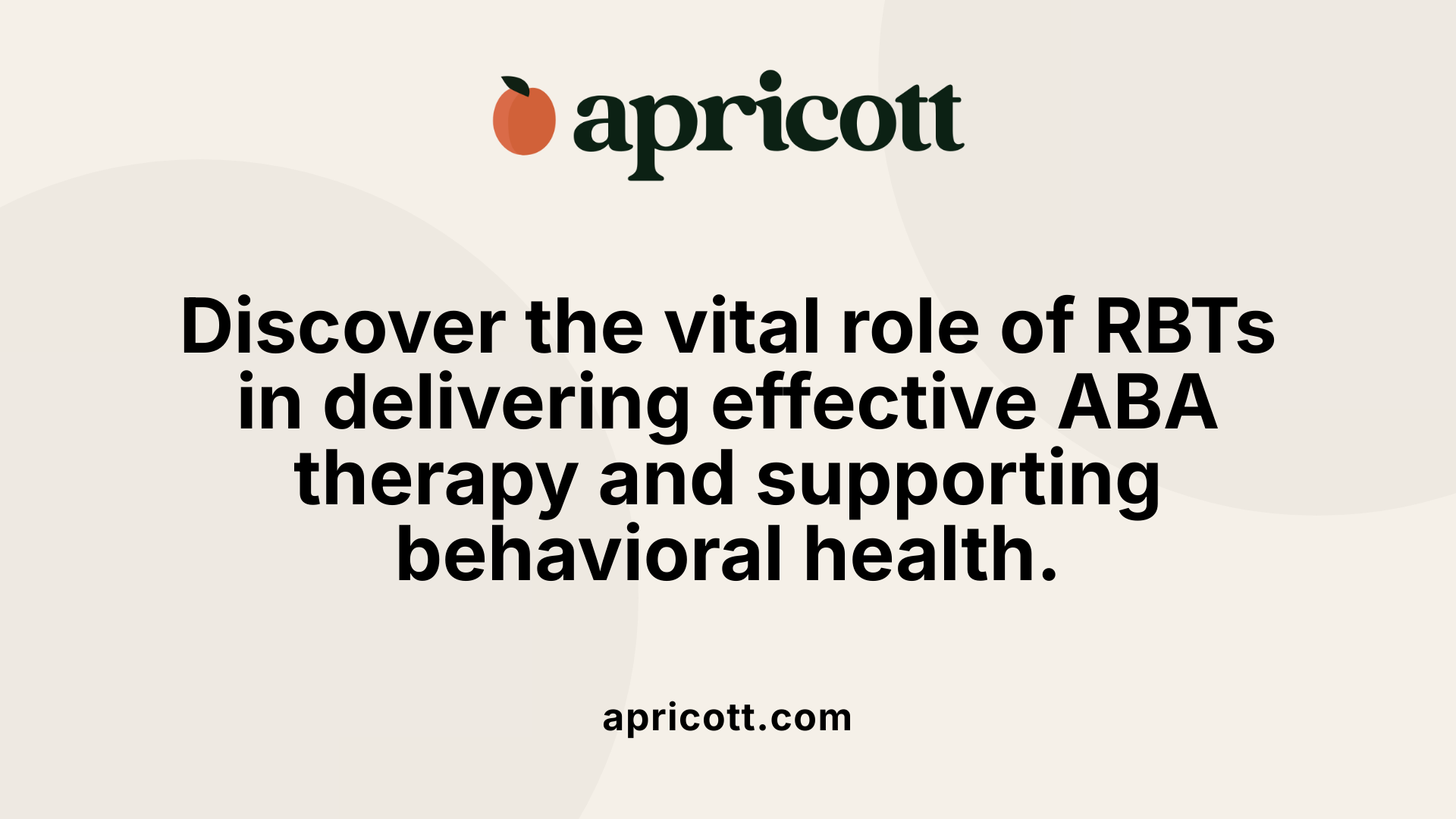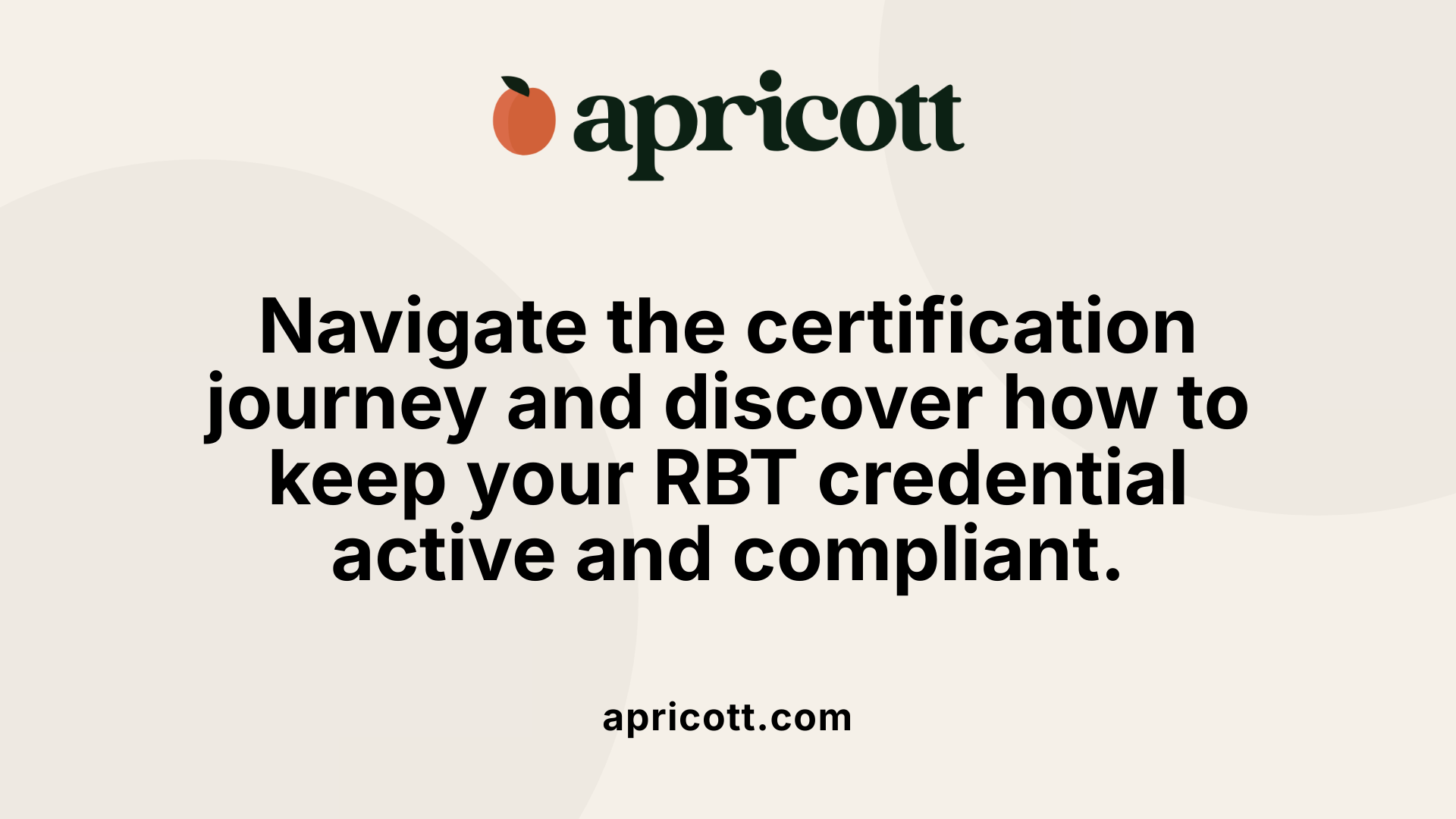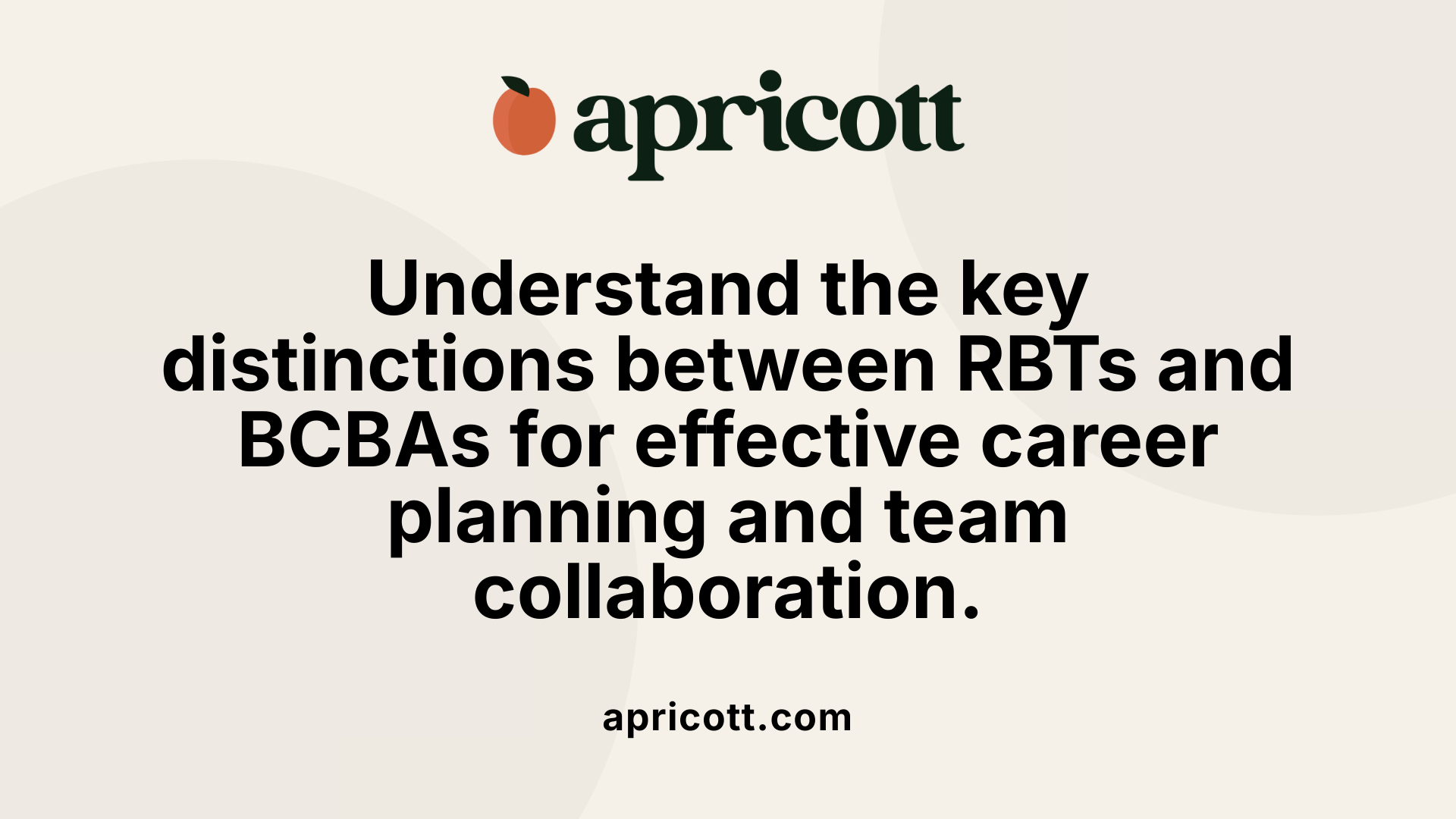July 25, 2025
Understanding the Frontline in Behavioral Therapy
In the expanding field of behavioral health, especially within applied behavior analysis (ABA), the role of the Registered Behavior Technician (RBT) has become increasingly vital. These professionals serve as the frontline workers implementing evidence-based interventions that significantly improve the lives of individuals with developmental disabilities, including autism spectrum disorder (ASD). This article explores what an RBT is, the qualifications required, the certification process, and how they fit into the broader scope of behavioral therapy.

An RBT, or Registered Behavior Technician, is a trained paraprofessional dedicated to supporting behavioral health through evidence-based practices. Certified by the Behavior Analyst Certification Board (BACB), RBTs are essential members of the behavioral therapy team. They work directly with clients, primarily focusing on delivering applied behavior analysis (ABA) interventions under the supervision of a Board Certified Behavior Analyst (BCBA).
The main role of an RBT is to implement personalized treatment plans designed by BCBAs. These plans aim to help individuals, often children with autism spectrum disorder (ASD), develop communication skills, social interactions, independence, and reduce problematic behaviors. RBTs are responsible for executing specific strategies such as positive reinforcement, functional communication training, and natural environment teaching. They are also involved in collecting data during sessions, which helps monitor clients’ progress and informs adjustments to therapy.
To become an RBT, candidates must fulfill certain requirements. These include being at least 18 years old, holding a high school diploma or equivalent, completing a 40-hour training course aligned with BACB standards, passing a competency assessment overseen by a BCBA, and successfully passing the RBT certification exam. Once certified, RBTs must also engage in ongoing supervision, comply with ethical guidelines, and renew their certification annually.
In practice, RBTs serve as front-line workers who carry out interventions in various settings such as homes, schools, hospitals, clinics, and residential facilities. These settings facilitate the implementation of behavior support strategies tailored to each individual’s needs, fostering meaningful progress across cognitive, communicative, and social domains. Through their direct engagement, RBTs play a vital role in helping clients achieve greater independence and improve their quality of life.
RBTs operate in a diverse range of environments, including:
In each setting, RBTs collaborate with families, educators, and other health professionals to deliver consistent, effective behavioral interventions. Their role is instrumental in ensuring the successful implementation of therapy plans and data collection, thereby supporting evidence-based decision making.
RBTs employ a variety of behavioral techniques grounded in ABA principles:
By utilizing these techniques, RBTs help clients acquire essential skills efficiently, reducing behaviors that interfere with daily life. Their practical application of behavioral strategies makes them integral to successful ABA therapy outcomes.
| Role/Setting | Description | Techniques Used |
|---|---|---|
| Direct service provider | Implements therapy plans with clients | Positive reinforcement, natural environment teaching |
| Data collection | Monitors progress and adjusts interventions | Measurement, assessment tools |
| Skill acquisition | Teaches daily living, communication, social skills | DTT, chaining, FCT |
| Behavioral support | Reduces problematic behaviors | Behavior reduction procedures |
| Work environments | Homes, schools, clinics, hospitals | All ABA techniques listed |
RBTs, with their specialized training and close supervision, form the backbone of ABA service delivery. Their hands-on work significantly contributes to the development and well-being of individuals with behavioral challenges, exemplifying the vital role they play in modern behavioral therapy communities.

Becoming a Registered Behavior Technician (RBT) involves a series of specific steps to ensure candidates are adequately prepared for the role. The process begins with meeting basic age and education prerequisites.
Candidates must be at least 18 years old to pursue RBT certification. A high school diploma or equivalent (such as a GED) is mandatory. This foundational requirement ensures that applicants have the basic educational background necessary for the training and responsibilities involved.
Next, aspiring RBTs must complete a 40-hour training course. This training is provided by BACB-approved organizations and covers essential topics like applied behavior analysis (ABA) principles, ethics, data collection, behavior intervention strategies, and safety protocols. The course is designed to prepare candidates for practical application and to fulfill BACB's standards.
Applicants are required to undergo a criminal background check and an abuse registry check. These checks are crucial to verify that candidates do not pose a risk to clients, especially vulnerable populations such as children with autism spectrum disorder (ASD). Additionally, candidates must successfully complete an initial competency assessment overseen by a qualified professional, usually a BCBA, to demonstrate practical understanding and skills.
Once candidates fulfill the training and assessment prerequisites, they must apply for certification through the BACB. The application involves submitting documentation of completed training, passing the background checks, and the competency assessment. The final step is passing the RBT certification exam, which tests knowledge of ABA principles, ethical considerations, and practical skills.
The exam comprises 85 multiple-choice questions and must be completed within 90 minutes. After passing the exam, the individual is officially recognized as an RBT. To maintain certification, RBTs must participate in ongoing supervision, complete annual competency assessments, and adhere to ethics standards.
This structured pathway ensures that RBTs are qualified, competent, and prepared to provide effective behavioral interventions under supervision.
| Step | Requirements | Additional Details |
|---|---|---|
| Age and Education | Minimum 18 years old, high school diploma or GED | Ensures basic readiness for training and responsibilities |
| Training | 40 hours of approved ABA training | Covers ABA principles, ethics, practical skills |
| Background Check | Criminal background and abuse registry checks | Ensures safety and suitability for working with clients |
| Competency Assessment | Successful completion with a BCBA | Demonstrates practical skill proficiency |
| Certification Exam | 85 multiple-choice questions, 90-minute limit | Final assessment to ensure knowledge and understanding |
| Maintenance | Annual supervision, continuing education, ongoing assessments | Certify of ongoing competence and ethics adherence |
For more detailed guidance, prospective RBTs can visit the official BACB website or contact approved training providers for comprehensive resources and support.

Becoming a Registered Behavior Technician (RBT) involves several structured steps designed to ensure that candidates are well-prepared to support behavior analysis services. The process begins with reviewing the official RBT Handbook provided by the Behavior Analyst Certification Board (BACB) to understand all the requirements and responsibilities.
Candidates must meet basic eligibility criteria, which include being at least 18 years old, holding a high school diploma or equivalent, passing a criminal background check, and completing a 40-hour training course specifically aligned with BACB standards. This training covers essential topics such as ethical considerations, data collection, behavior reduction, and skill acquisition procedures.
After completing training, the next phase is the Competency Assessment. This assessment is conducted by a supervising Board Certified Behavior Analyst (BCBA) or a qualified professional. It involves demonstrating practical skills and understanding of behavior intervention techniques. Successfully passing this assessment is mandatory before applying for certification.
To apply, candidates submit an online application through their BACB account, including documentation of training hours, competency assessment results, and background clearance. After approval, they schedule and take the RBT examination, which is administered via Pearson VUE testing centers. The exam comprises 85 multiple-choice questions focused on areas such as measurement, assessment, skill acquisition, behavior reduction, and professional conduct.
Achieving certification makes the individual an officially recognized RBT, capable of implementing behavior plans under supervision. However, maintaining this credential involves ongoing responsibilities.
RBTs are required to participate in regular supervision, which includes at least two face-to-face contacts per month with their supervisors. During these sessions, they receive feedback, discuss cases, and document supervision activities. These records must be retained for a minimum of seven years, ensuring accountability and continuous development.
To renew the certification annually, RBTs must submit a renewal application, complete a renewal competency assessment demonstrating current skills, and pay a renewal fee. They must also continue to comply with the BACB’s Ethics Code for Behavior Analysts, report any conduct or professional issues, and maintain ongoing ethical practice.
Additionally, RBTs are encouraged to engage in continuing education activities to stay updated on best practices, although specific CE requirements are less extensive compared to higher-level certifications like the BCBA. Staying current ensures that RBTs uphold the high standards expected in behavioral health support.
Overall, the pathway from obtaining to maintaining an RBT certification is designed to promote ethical, competent, and professional behavior intervention practitioners dedicated to improving the lives of individuals with behavioral challenges.
Registered Behavior Technicians (RBTs) play a vital role in delivering effective behavioral therapy, primarily working directly with clients to implement treatment plans designed by Board Certified Behavior Analysts (BCBAs). Their responsibilities include a variety of tasks centered around support, data collection, and behavioral intervention.
One of the core duties of an RBT is the implementation of behavior reduction strategies and skill acquisition protocols. These protocols target a range of behavioral goals, such as reducing problematic behaviors and teaching new, functional skills in communication, social interaction, and daily living activities.
RBTs work in personalized sessions, both one-on-one and in small groups, across settings like homes, schools, or clinics. They are responsible for executing specific interventions precisely as outlined in the treatment plan and making adaptations based on client response.
Data collection is fundamental to the RBT’s role. They meticulously record detailed information on client behaviors, progress, and reactions during each session. This data is then analyzed to monitor effectiveness and inform ongoing treatment modifications by the supervising BCBA.
In addition to direct service delivery, RBTs assist in conducting behavioral assessments under supervision. They may help gather information through observations, interviews, and assessments to contribute to treatment planning.
Support for clients extends beyond instruction. RBTs help teach new skills through reinforcement methods, natural environment teaching, and techniques like chaining, which links multiple behaviors into a sequential process.
Effective communication is another key component of their duties. RBTs regularly update families, caregivers, and team members on client progress, behavioral changes, and upcoming goals. They help educate families about behavioral strategies to promote generalization and consistency of interventions at home.
To facilitate smooth therapy sessions, RBTs also assist in preparing materials—visual aids, reinforcers, or session plans—and maintain accurate and detailed documentation to ensure compliance and high-quality care.
Overall, RBTs are frontline workers crucial for the practical application of ABA therapy. Their work helps children and adults develop necessary skills, reduce harmful behaviors, and increase independence, making their role both impactful and rewarding.
An RBT, or Registered Behavior Technician, is an essential part of the behavioral health system, especially within the scope of Applied Behavior Analysis (ABA) therapy. They serve as front-line practitioners who implement treatment plans designed by licensed professionals like BCBAs (Board Certified Behavior Analysts).
These paraprofessionals are trained to execute specific behavioral interventions, such as teaching communication skills, social behaviors, and daily living skills. They also assist in reducing problematic behaviors by applying proven behavioral principles like reinforcement and natural environment teaching.
Working across a variety of settings—including homes, schools, clinics, and hospitals—RBTs help foster the development of clients with developmental disabilities, particularly children with autism spectrum disorder (ASD). Their work supports clients' progress in establishing independence and improving overall quality of life.
In the broader context, RBTs are vital because they convert complex treatment strategies into practical actions that benefit clients directly. Their contributions are closely monitored through ongoing supervision and regular assessments to uphold high standards of care.
Through their direct engagement, RBTs help bridge the gap between theoretical behavioral strategies and real-world application, making them indispensable in the continuum of behavioral health and ABA services.
RBTs work alongside BCBAs, who develop and oversee treatment plans, and BCaBAs (Board Certified Assistant Behavior Analysts), who may also supervise RBTs. This team-based approach ensures comprehensive, ethical, and individualized care.
All RBTs operate under strict supervision to ensure ethical practice, adherence to BACB guidelines, and data integrity. They are required to complete ongoing training, complete competency assessments, and maintain certification annually.
By consistently implementing treatment protocols, collecting precise data, and maintaining client engagement, RBTs significantly contribute to positive behavioral and developmental outcomes. Their role helps maximize the effectiveness of ABA therapy.
Starting as an RBT offers a foundational career in behavioral health, with opportunities to pursue advanced certifications such as BCaBA and BCBA. Many professionals use their RBT experience as a stepping stone for higher education and specialized roles in behavioral analysis.
| Role | Responsibilities | Supervision Level | Certification Requirement |
|---|---|---|---|
| RBT | Implement therapy, collect data, support clients | Supervised by BCBA or BCaBA | RBT Certification from BACB |
| BCaBA | Develop treatment plans, supervise RBTs | Supervised by BCBA | Bachelor's in Behavior Analysis or related field |
| BCBA | Assess behaviors, design treatment strategies | Independent | Master’s degree and certification |
The demand for qualified professionals in this field continues to grow, making RBTs a promising entry point for a career in behavioral health.

The distinctions between Registered Behavior Technicians (RBTs) and Board Certified Behavior Analysts (BCBAs) are marked by their training, responsibilities, level of independence, and career outlook.
Training and Qualifications: RBTs are paraprofessionals who must complete a 40-hour training course based on the BACB’s RBT Task List. They are required to pass a competency assessment and their certification must be renewed annually, which involves ongoing supervision and adherence to ethical standards.
In contrast, BCBAs are highly trained professionals with at least a master's degree in behavior analysis or a related field. They complete over 300 hours of graduate coursework, obtain supervised fieldwork, and pass a rigorous certification exam. Their education and experience enable them to assess behaviors, develop treatment plans, and oversee ABA services.
Scope of Responsibilities: RBTs mainly implement behavioral interventions, collect data, and support the execution of treatment plans designed by BCBAs. They work directly with clients in settings such as schools, clinics, and residential homes. RBTs do not design treatment plans or conduct assessments.
BCBAs, on the other hand, are responsible for assessment, developing treatment controls, supervising RBTs, and making clinical decisions. They evaluate behavioral issues, create tailored intervention strategies, and oversee the entire therapy process.
Independence and Supervision: RBTs are front-line practitioners who operate strictly under the close supervision of a BCBA. They cannot work independently and are accountable to their supervising analysts.
BCBAs have the professional autonomy to assess clients, devise treatment methods, and supervise multiple RBTs and other staff members. Their role entails a greater level of independence in decision-making and oversight.
Salaries and Career Progression: The typical hourly wage for RBTs ranges from $15 to $23, with annual salaries usually between $30,000 and $50,000, depending on experience and location. Many RBTs view the role as a stepping stone toward advanced positions in behavior analysis.
BCBAs generally earn substantially higher salaries, often exceeding $70,000 annually, reflecting their advanced education, responsibilities, and professional standing. The pathway from RBT to BCBA involves further education, practical experience, and passing certification exams, allowing for career advancement within the field of behavior analysis.
| Aspect | RBTs | BCBAs | Details | |------------------------------|------------------------------|--------------------------------------------------| | Education | High school diploma + 40-hour training | Master's degree + coursework | | Certification | RBT certification via BACB | BCBA certification via BACB | | Responsibilities | Implementing behavior plans, data collection | Designing, assessing, supervising | | Independence | Works under supervision | Professional autonomy | | Salary Range | $15 - $23/hour | $70,000+ annually | | Career Path | Entry point in ABA | Advanced clinical roles |
Understanding these differences is essential for anyone interested in pursuing a career in behavior analysis or organizations aiming to hire qualified professionals. Both roles are vital in delivering effective ABA therapy and supporting individuals with behavioral challenges.
As the demand for behavioral health services continues to grow, the role of the RBT remains at the forefront of delivering effective, evidence-based interventions. These paraprofessionals serve as the essential link between theoretical treatment plans crafted by BCBAs and the practical implementation that leads to meaningful client progress. With increasing awareness of ABA’s benefits and expanding job opportunities, becoming an RBT offers a promising pathway for individuals interested in making a tangible difference in the lives of those with behavioral challenges. Resources like the BACB support ongoing professional development, ensuring RBTs can sustain professionalism and grow within this vital field. As careers advance, many RBTs pursue further education, such as becoming BCBAs, fostering a robust professional community dedicated to improving behavioral health outcomes.